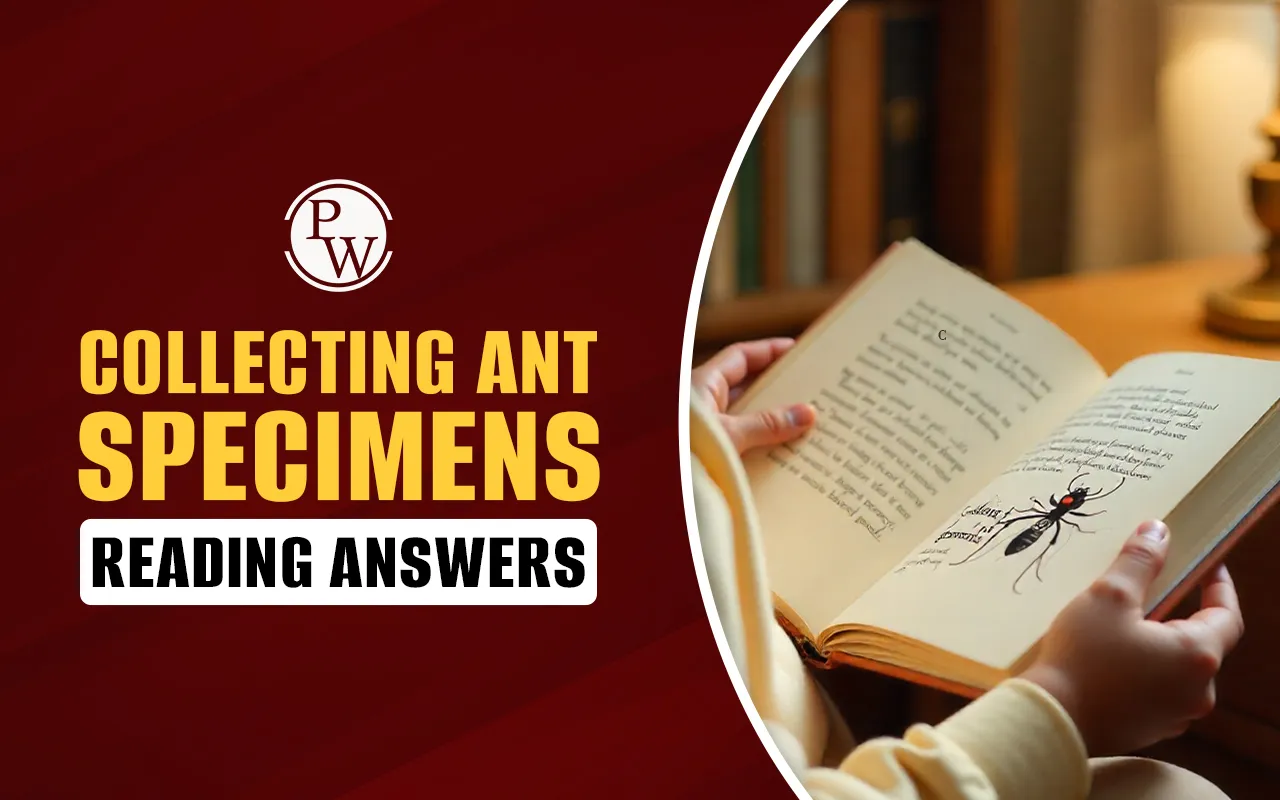

Collecting Ant Specimens Reading Answers passage is a fascinating text from the IELTS exam. It explains methods used in insect studies and is often part of ant specimens IELTS reading. Learners face collecting ant specimens reading questions, and later check collecting ant specimens reading answers for practice.
Since it appears in IELTS Reading Topics, knowing the IELTS Reading Test Format and different IELTS Reading Question Types is crucial. Skills like tackling IELTS Reading multiple choice questions, IELTS Reading Sentence Completion Questions, and mastering the IELTS READING structure help. These strategies improve accuracy and boost your IELTS Reading Band Score.
IELTS Collecting Ant Specimens Reading Passage
The collecting ant specimens reading passage is a popular text in the IELTS exam. It focuses on research methods in entomology and helps candidates understand scientific descriptions. This ant specimen IELTS reading passage also develops comprehension skills useful for other insect research IELTS passage practice materials.
Collecting Ant Specimens Reading Passage
A. Collecting ants can be as simple as picking up stray ones and placing them in a glass jar or as complicated as completing an exhaustive survey of all species present in an area and estimating their relative abundances. The exact method used will depend on the final purpose of the collections. For taxonomy or classification, long series from a single nest, which contains all castes (workers, including majors and minors, and, if present, queens and males), are desirable to allow the determination of variation within species. For ecological studies, the most important factor is collecting identifiable samples of as many of the different species present as possible. Unfortunately, these methods are not always compatible. The taxonomist sometimes overlooks whole species in favour of those groups currently under study, while the ecologist often collects only a limited number of specimens of each species, thus reducing their value for taxonomic investigations.
B. To collect as wide a range of species as possible, several methods must be used. These include hand collecting, using baits to attract the ants, ground litter sampling, and the use of pitfall traps. Hand collecting consists of searching for ants everywhere they are likely to occur. This includes on the ground, under rocks, logs or other objects on the ground, in rotten wood on the ground or on trees, in vegetation, on tree trunks and under bark. When possible, collections should be made from nests or foraging columns, and at least 20 to 25 individuals should be collected. This will ensure that all individuals are of the same species and so increase their value for detailed studies. Since some species are largely nocturnal, collecting should not be confined to the daytime. Specimens are collected using an aspirator (often called a pooter), forceps, a fine, moistened paint brush, or fingers if the ants are known not to sting. Individual insects are placed in plastic or glass tubes (1.5-3-0 ml capacity for small ants, 5-8 ml for larger ants) containing 75% to 95% ethanol. Plastic tubes with secure tops are better than glass because they are lighter and do not break as easily if mishandled.
C. Baits can be used to attract and concentrate foragers. This often increases the number of individuals collected and attracts species that are otherwise elusive. Sugars and meats or oils will attract different species, and a range of these should be utilised. These baits can be placed either on the ground or on the trunks of trees or large shrubs. When placed on the ground, baits should be situated on small paper cards or other flat, light-coloured surfaces or in test tubes or vials. This makes it easier to spot ants and to capture them before they can escape into the surrounding leaf litter.
D. Many ants are small and forage primarily in the layer of leaves and other debris on the ground. Collecting these species by hand can be difficult. One of the most successful ways to collect them is to gather the leaf litter in which they are foraging and extract the ants from it. This is most commonly done by placing leaf litter on a screen over a large funnel, often under some heat. As the leaf litter dries from above, ants (and other animals) move downward and eventually fall out the bottom. They are collected in alcohol and placed below the funnel. This method works especially well in rainforests and marshy areas. A method of improving the catch when using a funnel is to sift the leaf litter through a coarse screen before placing it above the funnel. This will concentrate the litter and remove larger leaves and twigs. It will also allow more litter to be sampled when using a limited number of funnels.
E. The pitfall trap is another commonly used tool for collecting ants. A pitfall trap can be any small container placed on the ground at the top level of the surrounding surface and filled with a preservative. Ants are collected when they fall into the trap while foraging.
The diameter of the traps can vary from about 18 mm to 10 cm, and the number used can vary from a few to several hundred. The size of the traps used is influenced largely by personal preference (although larger sizes are generally better), while the number will be determined by the study being undertaken. The preservative used is usually ethylene glycol or propylene glycol, as alcohol will evaporate quickly and the traps will dry out.
F. One advantage of pitfall traps is that they can be used to collect over a period of time with minimal maintenance and intervention. One disadvantage is that some species are not collected as they either avoid the traps or do not commonly encounter them while foraging.
IELTS Collecting Ant Specimens Reading Questions
The collecting ant specimens reading questions test a student’s ability to analyze details, spot main ideas, and identify methods. These IELTS tasks often include multiple-choice, matching, or sentence completion. Practicing ant specimens IELTS reading improves accuracy and boosts performance in other insect research IELTS passage question formats.
| IELTS Collecting Ant Specimens Reading Questions | |||
| Q.No | Question Type | Question | Options (if applicable) |
| 1 | Multiple Choice | What does taxonomy in ant collection mainly require? | A) A few ants from many nests B) Long series from a single nest C) Only nocturnal ants D) Only winged ants |
| 2 | Multiple Choice | For ecological studies, the main goal is to: | A) Collect large numbers of ants from one nestB) Identify as many species as possible C) Study only queens and males D) Collect only nocturnal ants |
| 3 | True/False/Not Given | Taxonomists always collect every species available in an area. | — |
| 4 | True/False/Not Given | Plastic tubes are preferred over glass tubes for storing ants. | — |
| 5 | Sentence Completion | To ensure all ants belong to the same species, at least ______ individuals should be collected. | — |
| 6 | Sentence Completion | Ants collected by hand are usually stored in tubes containing ______. | — |
| 7 | Matching Features | Match the collecting method with its description: i. Hand collecting ii. Baits iii. Leaf litter funnel iv. Pitfall traps | A) Attracts ants using sugar or oil B) Searching under rocks, wood, and bark C) Ants extracted as litter dries D) Ants fall into preservative liquid |
| 8 | Multiple Choice | What should be used to collect ants if they are very small? | A) A large funnel B) Fingers C) An aspirator (pooter) D) A pitfall trap |
| 9 | Short Answer | Why should nocturnal collections also be considered? | — |
| 10 | Short Answer | What kind of ants are best collected with a leaf litter funnel? | — |
| 11 | True/False/Not Given | Pitfall traps are filled with alcohol as a preservative. | — |
| 12 | Multiple Choice | Which factor mostly influences the number of pitfall traps used? | A) The size of the ants B) The type of preservative C) The study requirements D) The season of the year |
| 13 | Sentence Completion | A method to improve funnel sampling is to ______ the leaf litter first. | — |
| 14 | Short Answer | What is one disadvantage of pitfall traps? | — |
| 15 | Matching Information | Which section mentions: i. The risk of overlooking species ii. The use of sugars and oils iii. Avoiding glass containers iv. Sifting leaf litter | A) Section A B) Section B C) Section C D) Section D |
IELTS Collecting Ant Specimens Reading Answers
The collecting ant specimens reading answers guide helps learners verify responses and track mistakes. Reviewing correct solutions builds confidence and highlights common errors. By checking answers carefully, students strengthen comprehension and improve performance in both the ant specimens IELTS reading and other insect research IELTS passage practice tests.
| IELTS Collecting Ant Specimens Reading Answers | |||
| Q.No | Question Type | Question | Answer |
| 1 | Multiple Choice | What does taxonomy in ant collection mainly require? | B – Long series from a single nest |
| 2 | Multiple Choice | For ecological studies, the main goal is to: | B – Identify as many species as possible |
| 3 | True/False/Not Given | Taxonomists always collect every species available in an area. | False |
| 4 | True/False/Not Given | Plastic tubes are preferred over glass tubes for storing ants. | True |
| 5 | Sentence Completion | To ensure all ants belong to the same species, at least ______ individuals should be collected. | 20 to 25 |
| 6 | Sentence Completion | Ants collected by hand are usually stored in tubes containing ______. | 75% to 95% ethanol |
| 7 | Matching Features | Match the collecting method with its description: i. Hand collecting ii. Baits iii. Leaf litter funnel iv. Pitfall traps | i → B ii → A iii → C iv → D |
| 8 | Multiple Choice | What should be used to collect ants if they are very small? | C – An aspirator (pooter) |
| 9 | Short Answer | Why should nocturnal collections also be considered? | Because some species are active mainly at night. |
| 10 | Short Answer | What kind of ants are best collected with a leaf litter funnel? | Small ants that forage in leaf litter. |
| 11 | True/False/Not Given | Pitfall traps are filled with alcohol as a preservative. | False – They use glycol as alcohol evaporates. |
| 12 | Multiple Choice | Which factor mostly influences the number of pitfall traps used? | C – The study requirements |
| 13 | Sentence Completion | A method to improve funnel sampling is to ______ the leaf litter first. | sift |
| 14 | Short Answer | What is one disadvantage of pitfall traps? | Some species avoid traps or do not encounter them. |
| 15 | Matching Information | Which section mentions: i. The risk of overlooking species ii. The use of sugars and oils iii. Avoiding glass containers iv. Sifting leaf litter | i → A ii → C iii → B iv → D |
Guidance to PW IELTS Prep
IELTS Online Courses is a great initiative Physics Wallah took to help IELTS aspirants better prepare for the exam. Follow our below pages to learn more about the IELTS exam.| IELTS Reading Band Score | IELTS Listening Band Score |
| IELTS Speaking Band Score | IELTS Writing Band Score |
IELTS Collecting Ant Specimens Reading Answers FAQs
Why is collecting a long series of ants from one nest important?
What preservative is best for storing ants?
Why use an aspirator (pooter) in ant collection?
What is the main purpose of pitfall traps?
Why should nocturnal ant collections be done?












